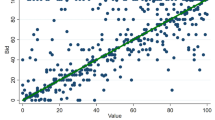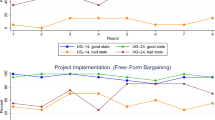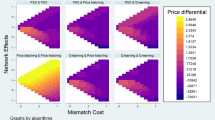Abstract
Privacy has become a factor of increasing importance in auction design. We propose general techniques for cryptographic first-price and (M+1)st-price auction protocols that only yield the winners' identities and the selling price. Moreover, if desired, losing bidders learn no information at all, except that they lost. Our security model is merely based on computational intractability. In particular, our approach does not rely on trusted third parties, e.g., auctioneers. We present an efficient implementation of the proposed techniques based on El Gamal encryption whose security only relies on the intractability of the decisional Diffie—Hellman problem. The resulting protocols require just three rounds of bidder broadcasting in the random oracle model. Communication complexity is linear in the number of possible bids.
Similar content being viewed by others
References
Abe, M., Suzuki, K.: M+1-st price auction using homomorphic encryption. In: Proceedings of the 5th International Conference on Public Key Cryptography (PKC). Lecture Notes in Computer Science (LNCS), vol. 2274, pp. 115–224. Springer, Berlin Heidelberg New York (2002)
Baudron, O., Stern, J.: Non-interactive private auctions. In: Proceedings of the 5th Annual Conference on Financial Cryptography (FC). Lecture Notes in Computer Science (LNCS), vol. 2339, pp. 300–313. Springer, Berlin Heidelberg New York (2001)
Ben-Or, M., Goldwasser, S., Wigderson, A.: Completeness theorems for non-cryptographic fault-tolerant distributed computation. In: Proceedings of the 20th Annual ACM Symposium on the Theory of Computing (STOC), pp. 1–10. ACM, New York (1988)
Brandt, F.: Secure and private auctions without auctioneers. Tech. Rep. FKI-245-02, Department for Computer Science, Technical University of Munich, Munich (2002). ISSN 0941-6358
Brandt, F.: A verifiable, bidder-resolved auction protocol. In: Falcone, R., Barber, S., Korba, L., Singh, M. (eds.) Proceedings of the 5th AAMAS Workshop on Deception, Fraud and Trust in Agent Societies (Special Track on Privacy and Protection with Multi-Agent Systems), pp. 18–25 (2002)
Brandt, F.: Fully private auctions in a constant number of rounds. In: Wright, R.N. (ed.) Proceedings of the 7th Annual Conference on Financial Cryptography (FC). Lecture Notes in Computer Science (LNCS), vol. 2742, pp. 223–238. Springer-Verlag, Berlin Heidelberg New York (2003)
Brandt, F.: Social choice and preference protection—Towards fully private mechanism design. In: Nisan, N. (ed.) Proceedings of the 4th ACM Conference on Electronic Commerce, pp. 220–221. ACM, New York (2003)
Brandt, F., Sandholm, T.: (Impossibility of unconditionally privacy-preserving auctions. In: Sierra, C., Sonenberg, L. (eds.) Proceedings of the 3rd International Joint Conference on Autonomous Agents and Multi-Agent Systems (AAMAS), pp. 810–817. ACM, New York (2004)
Brandt, F., Sandholm, T.: On correctness and privacy in distributed mechanisms. In: Faratin, P., Rodriguez-Aguilar, J.A. (eds.) Selected and revised papers from the 6th AAMAS Workshop on Agent-Mediated Electronic Commerce (AMEC). Lecture Notes in Artificial Intelligence (LNAI), vol. 3435 (2004)
Brandt, F., Sandholm, T.: Efficient privacy-preserving protocols for multi-unit auctions. In: Patrick, A., Yung, M. (eds.) Proceedings of the 9th International Conference on Financial Cryptography and Data Security (FC). Lecture Notes in Computer Science (LNCS), vol. 3570, pp. 298–312. Springer, Berlin Heidelberg New York (2005)
Chaum, D., Crépeau, C., Damgård, I.: Multi-party unconditionally secure protocols. In: Proceedings of the 20th Annual ACM Symposium on the Theory of Computing (STOC), pp. 11–19. ACM, New York (1988)
Chaum, D., Pedersen, T.P.: Wallet databases with observers. In: Advances in Cryptology—Proceedings of the 12th Annual International Cryptology Conference (CRYPTO). Lecture Notes in Computer Science (LNCS), vol. 740, pp. 3.1–3.6. Springer, Berlin Heidelberg New York (1992)
Chen, W.: Kryptographische Auktionsprotokolle Implementie—rung und Analyse (2002). Systementwicklungsprojekt, Department for Computer Science, Technical University of Munich. http://www.chenwilly.info
Cramer, R., Damgård, I., Schoenmakers, B.: Proofs of partial knowledge and simplified design of witness hiding protocols. In: Advances in Cryptology—Proceedings of the 14th Annual International Cryptology Conference (CRYPTO). Lecture Notes in Computer Science (LNCS), vol. 893, pp. 174–187. Springer, Berlin Heidelberg New York (1994)
Cramer, R., Gennaro, R., Schoenmakers, B.: A secure and optimally efficient multi-authority election scheme. In: Advances in Cryptology—Proceedings of the 14th Eurocrypt Conference. Lecture Notes in Computer Science (LNCS), vol. 1233, pp. 103–118. Springer, Berlin Heidelberg New York (1997)
Damgård, I.: On Σ-protocols. Lecture Notes, University of Aarhus, Department for Computer Science (2002)
El Gamal, T.: A public key cryptosystem and a signature scheme based on discrete logarithms. IEEE Trans. Inf. Theory 31, 469–472 (1985)
Fiat, A., Shamir, A.: How to prove yourself: Practical solutions to identification and signature problems. In: Advances in Cryptology—Proceedings of the 12th Annual International Cryptology Conference (CRYPTO). Lecture Notes in Computer Science (LNCS), pp. 186–194. Springer, Berlin Heidelberg New York (1987)
Franklin, M.K., Reiter, M.K.: The design and implementation of a secure auction service. IEEE Trans. Softw. Eng. 22(5), 302–312 (1996)
Garay, J., MacKenzie, P., Yang, K.: Efficient and secure multi-party computation with faulty majority and complete fairness. Cryptology ePrint Archive, Report 2004/009 (2004)
Gennaro, R., Jarecki, S., Krawczyk, H., Rabin, T.: Applications of Pedersen's distributed key generation protocol. In: Proceedings of the Cryptographers' Track at the 12th RSA Conference. Lecture Notes in Computer Science (LNCS), vol. 2612, pp. 373–390. Springer, Berlin Heidelberg New York (2003)
Goldreich, O.: Foundations of Cryptography, vol. 2. Basic Applications. Cambridge University Press, Cambridge (2004)
Goldreich, O., Micali, S., Wigderson, A.: How to play any mental game or a completeness theorem for protocols with honest majority. In: Proceedings of the 19th Annual ACM Symposium on the Theory of Computing (STOC), pp. 218–229. ACM, New York (1987)
Goldwasser, S., Levin, L.: Fair computation of general functions in presence of immoral majority. In: Advances in Cryptology—Proceedings of the 10th Annual International Cryptology Conference (CRYPTO). Lecture Notes in Computer Science (LNCS), vol. 537, pp. 77–93. Springer, Berlin Heidelberg New York (1990)
Goldwasser, S., Lindell, Y.: Secure computation without agreement. In: Proceedings of the 16th International Symposium on Distributed Computing (DISC). Lecture Notes in Computer Science (LNCS), vol. 2508, pp. 17–32. Springer, Berlin Heidelberg New York (2002)
Groth, J.: Efficient maximal privacy in boardroom voting and anonymous broadcast. In: Proceedings of the 8th Annual Conference on Financial Cryptography (FC). Lecture Notes in Computer Science (LNCS), vol. 3110, pp. 90–104. Springer, Berlin Heidelberg New York (2004)
Harkavy, M., Tygar, J.D., Kikuchi, H.: Electronic auctions with private bids. In: Proceedings of the 3rd USENIX Workshop on Electronic Commerce, pp. 61–74 (1998)
Jakobsson, M., Juels, A.: Mix and match: Secure function evaluation via ciphertexts. In: Proceedings of the 6th Asiacrypt Conference. Lecture Notes in Computer Science (LNCS), vol. 1976, pp. 162–177. Springer, Berlin Heidelberg New York (2000)
Juels, A., Szydlo, M.: A two-server, sealed-bid auction protocol. In: Blaze, M. (ed.) Proceedings of the 6th Annual Conference on Financial Cryptography (FC). Lecture Notes in Computer Science (LNCS), vol. 2357, pp. 72–86. Springer, Berlin Heidelberg New York (2002)
Kiayias, A., Yung, M.: Self-tallying elections and perfect ballot secrecy. In: Proceedings of the 5th International Workshop on Practice and Theory in Public Key Cryptography (PKC), no. 2274. Lecture Notes in Computer Science (LNCS), pp. 141–158. Springer, Berlin Heidelberg New York (2002)
Kiayias, A., Yung, M.: Non-interactive zero-sharing with applications to private distributed decision making. In: Proceedings of the 7th Annual Conference on Financial Cryptography (FC). Lecture Notes in Computer Science (LNCS), vol. 2742, pp. 303–320. Springer, Berlin Heidelberg New York (2003)
Kikuchi, H.: (M+1)st-price auction protocol. In: Proceedings of the 5th Annual Conference on Financial Cryptography (FC). Lecture Notes in Computer Science (LNCS), vol. 2339, pp. 351–363. Springer, Berlin Heidelberg New York (2001)
Klemperer, P.: Auction theory: A guide to the literature. J. Econ. Surv. 13(3), 227–286 (1999)
Krishna, V.: Auction Theory. Academic, New York (2002)
Lipmaa, H., Asokan, N., Niemi, V.: Secure Vickrey auctions without threshold trust. In: Blaze, M. (ed.) Proceedings of the 6th Annual Conference on Financial Cryptography (FC). Lecture Notes in Computer Science (LNCS), vol. 2357, pp. 87–101. Springer, Berlin Heidelberg New York (2002)
Naor, M., Pinkas, B., Sumner, R.: Privacy preserving auctions and mechanism design. In: Proceedings of the 1st ACM Conference on Electronic Commerce (ACM-EC), pp. 129–139. ACM, New York (1999)
Nurmi, H., Salomaa, A.: Cryptographic protocols for Vickrey auctions. Group Decis. Negot. 2, 363–373 (1993)
Pass, R.: Bounded-concurrent secure multiparty computation with a dishonest majority. In: Proceedings of the 36th Annual ACM Symposium on the Theory of Computing (STOC), pp. 232–241. ACM, New York (2004)
Pedersen, T.: Non-interactive and information-theoretic secure verifiable secret sharing. In: Feigenbaum, J. (ed.) Advances in Cryptology—Proceedings of the 11th Annual International Cryptology Conference (CRYPTO). Lecture Notes in Computer Science (LNCS), vol. 576, pp. 129–140. Springer, Berlin Heidelberg New York (1991)
Pinkas, B.: Fair secure two-party computation. In: Proceedings of the 20th Eurocrypt Conference. Lecture Notes in Computer Science (LNCS), vol. 2656, pp. 87–105. Springer, Berlin Heidelberg New York (2003)
Porter, R., Shoham, Y.: On cheating in sealed-bid auctions. In: Proceedings of the 4th ACM Conference on Electronic Commerce (ACM-EC), pp. 76–84. ACM, New York (2003)
Rothkopf, M.H., Harstad, R.M.: Two models of bid-taker cheating in Vickrey auctions. J. Business 68(2), 257–267 (1995)
Rothkopf, M.H., Teisberg, T.J., Kahn, E.P.: Why are Vickrey auctions rare? J. Pol. Econ. 98(1), 94–109 (1990)
Sako, K.: An auction protocol which hides bids of losers. In: Proceedings of the 3rd International Conference on Public Key Cryptography (PKC). Lecture Notes in Computer Science (LNCS), vol. 1751, pp. 422–432. Springer, Berlin Heidelberg New York (2000)
Sandholm, T.: Issues in computational Vickrey auctions. International Journal of Electronic Commerce, Special Issue Intell. Agents Electron. Commer. 4(3), 107–129 (2000)
Schnorr, C.P.: Efficient signature generation by smart cards. J. Cryptol. 4(3), 161–174 (1991)
Suzuki, K., Yokoo, M.: Secure combinatorial auctions by dynamic programming with polynomial secret sharing. In: Proceedings of the 6th Annual Conference on Financial Cryptography (FC). Lecture Notes in Computer Science (LNCS), vol. 2357. Springer, Berlin Heidelberg New York (2002)
Suzuki, K., Yokoo, M.: Secure generalized Vickrey auction using homomorphic encryption. In: Proceedings of the 7th Annual Conference on Financial Cryptography (FC). Lecture Notes in Computer Science (LNCS), vol. 2742, pp. 239–249. Springer, Berlin Heidelberg New York (2003)
Tsiounis, Y., Yung, M.: On the security of El Gamal-based encryption. In: Proceedings of the 1st International Workshop on Practice and Theory in Public Key Cryptography (PKC). Lecture Notes in Computer Science (LNCS), vol. 1431, pp. 117–134. Springer, Berlin Heidelberg New York (1998)
Vickrey, W.: Counter speculation, auctions, and competitive sealed tenders. J. Finance 16(1), 8–37 (1961)
Yao, A.C.: How to generate and exchange secrets. In: Proceedings of the 27th Symposium on Foundations of Computer Science (FOCS), pp. 162–167. IEEE Comput. Soc. Press (1986)
Author information
Authors and Affiliations
Corresponding author
Rights and permissions
About this article
Cite this article
Brandt, F. How to obtain full privacy in auctions. Int. J. Inf. Secur. 5, 201–216 (2006). https://doi.org/10.1007/s10207-006-0001-y
Published:
Issue Date:
DOI: https://doi.org/10.1007/s10207-006-0001-y




